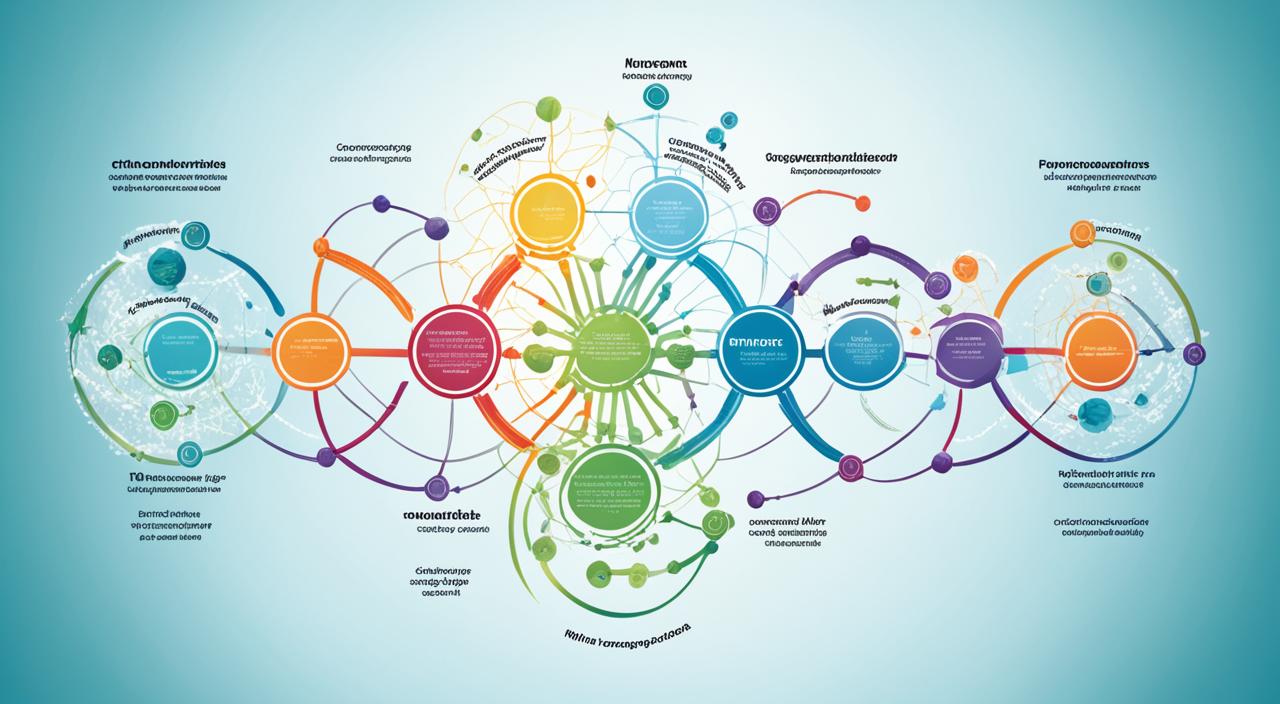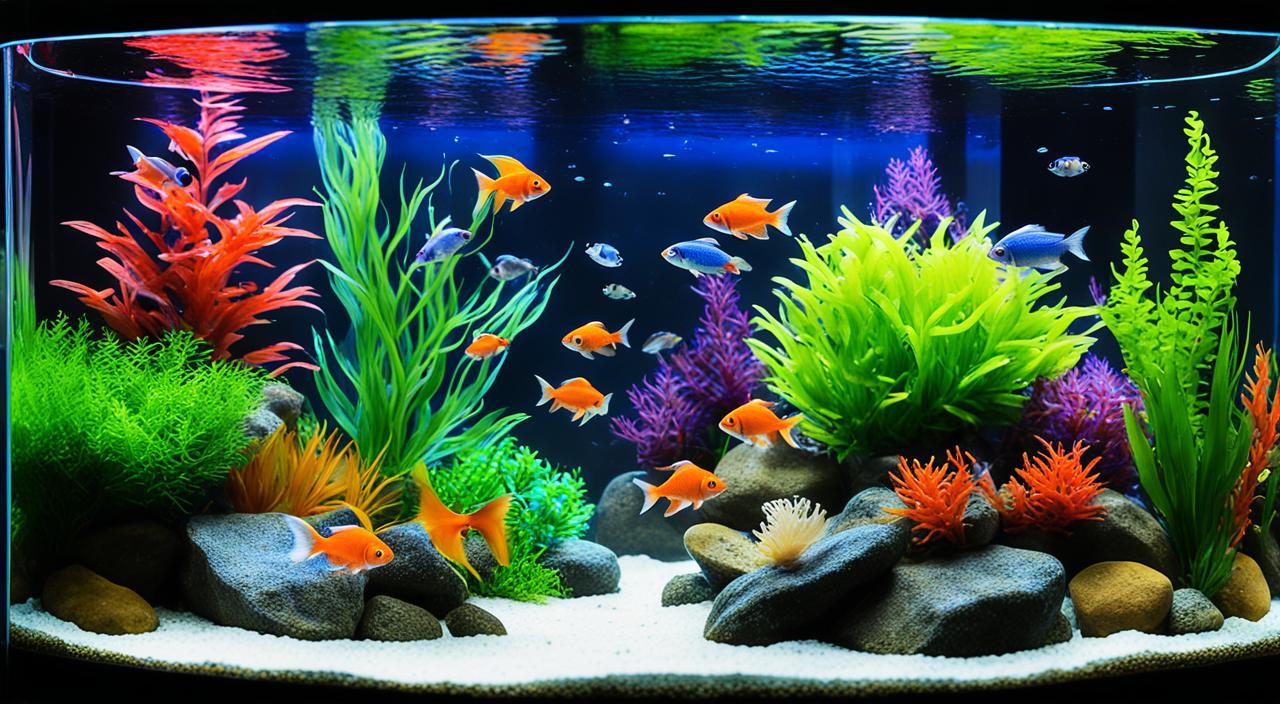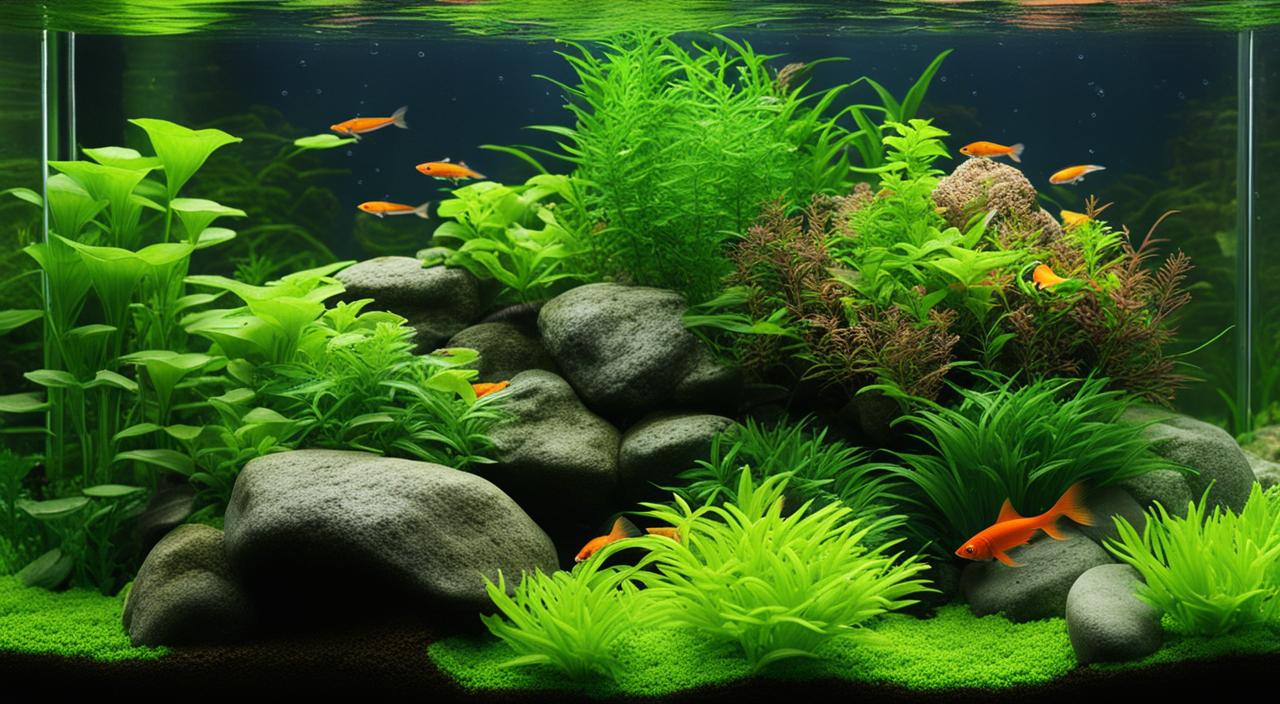Regarding the nitrogen cycle, numerous misconceptions often cloud our understanding of this crucial ecosystem process. In this article, I will provide you with a comprehensive overview of the nitrogen cycling process and debunk some of the most common myths associated with it. By dispelling these misconceptions, we can better understand how nitrogen cycles through our environment, from aquarium maintenance to agricultural practices.
Key Takeaways:
- Understanding the nitrogen cycle is essential for proper aquarium maintenance and agricultural practices.
- There are several common misconceptions surrounding the nitrogen cycling process.
- Cycling an aquarium is crucial for establishing a healthy aquatic environment.
- The myth of a fourth “denitrifying” step in the nitrogen cycle is debunked.
- Optimal nitrogen application in agriculture maximizes yields and minimizes environmental impact.
Understanding the Nitrogen Cycle
The nitrogen cycle is a fascinating and essential natural process in various ecosystems, including aquariums and agricultural fields. It involves the conversion of nitrogen in the environment, maintaining a delicate balance that supports life. To grasp the intricacies of this cycle, it’s crucial to understand the steps involved and the bacteria that drive the process.
The Steps of the Nitrogen Cycle
The nitrogen cycle consists of several key steps that work in harmony to ensure the efficient utilization of nitrogen:
- Ammonification: The cycle begins with decomposing organic matter, such as dead plants and animal waste, by bacteria and fungi. This decomposition releases ammonia (NH3) into the environment.
- Nitrification: In this step, specific bacteria convert ammonia into nitrite (NO2-) and oxidize it into nitrate (NO3-). Nitrite is highly toxic, while nitrate is less harmful to organisms.
- Assimilation: Plants and algae take nitrate from the environment through their root systems and utilize it for growth and metabolism. They convert nitrate into various nitrogen compounds, including proteins and DNA.
- Denitrification: Under anaerobic conditions, certain bacteria convert nitrate back into atmospheric nitrogen (N2) gas, completing the cycle. This step occurs in soils, wetlands, and other oxygen-depleted environments, not aquariums.
Aquarium enthusiasts and farmers can effectively manage nitrogen levels, create a stable and healthy environment, and optimize plant growth by understanding these steps.
Facts about the Nitrogen Cycle
Here are some essential facts about the nitrogen cycle:
- Nitrogen is essential for all living organisms, including plants, animals, and microbes. It is a vital component of DNA, RNA, and proteins.
- The nitrogen cycle is a continuous process that ensures a sustainable nitrogen supply in ecosystems.
- Specific bacteria, such as ammonifying, nitrifying, and denitrifying bacteria, facilitate the nitrogen cycle.
- The balance of nitrogen in the environment is crucial, as excessive nitrogen can lead to environmental pollution and harmful algal blooms.
Now that we have gained a basic understanding of the nitrogen cycle let’s explore the common misconceptions surrounding it and debunk these myths in the next section.
Common Misconceptions about Nitrogen Cycling
When it comes to the nitrogen cycle, several common misconceptions can mislead both aquarium hobbyists and farmers. Separating fact from fiction is essential to ensure proper maintenance and practices. One prevalent myth is that every hobbyist must fully understand the nitrogen cycle. While knowing the nitrogen cycle is beneficial, it is unnecessary for success in aquarium or crop production. This misconception has been perpetuated by ill-informed individuals on social media, causing unnecessary confusion.
To debunk the common misconceptions surrounding the nitrogen cycle, let’s examine some of these myths and provide clarifications:
- Myth: Every hobbyist must fully understand the nitrogen cycle.
Fact: While understanding the nitrogen cycle is valuable, it is not a prerequisite for a successful aquarium or crop production. Basic knowledge and awareness of the nitrogen cycle are sufficient for maintaining a healthy environment. It is always recommended to stay informed, but extensive expertise is unnecessary.
- Myth: The nitrogen cycle doesn’t apply to me because I use a biological filter or nitrogen-fixing plants.
Fact: The nitrogen cycle occurs in all aquatic and terrestrial ecosystems, regardless of a biological filter or nitrogen-fixing plants. These components can assist in the nitrogen cycling process but do not eliminate the need for understanding and managing the cycle.
- Myth: Adding more ammonia accelerates the nitrogen cycle.
Fact: The nitrogen cycle is natural and cannot be significantly accelerated by adding excessive ammonia. It is essential to allow the beneficial bacteria to establish and reach sufficient populations for efficient cycling. Adding excessive ammonia can hinder the process and lead to imbalances.
- Myth: The nitrogen cycle is the same in all environments.
Fact: While the fundamental principles of the nitrogen cycle remain the same, the specifics can vary depending on the environment. Factors such as temperature, pH, and the types of organisms present can influence the speed and efficiency of the nitrogen cycling process.
By debunking these myths, we can better understand the nitrogen cycle and promote proper aquarium maintenance and agricultural practices. It’s important to base our knowledge on accurate information and reliable sources rather than misconceptions.
The Importance of Cycling an Aquarium
Cycling an aquarium is essential for creating a healthy and thriving aquatic environment. It is a crucial step that every beginner aquarium enthusiast should understand and follow. This process involves the establishment of beneficial bacteria colonies in the filter media, which play a vital role in maintaining water quality and ensuring the well-being of fish and other aquatic organisms.
During the cycling process, these beneficial bacteria convert fish waste, such as ammonia and nitrite, into less toxic compounds. This conversion is known as the nitrogen cycle, and it helps maintain the delicate balance of nitrogen in the aquarium ecosystem. By properly cycling the aquarium, you can prevent the buildup of harmful levels of ammonia and nitrite, which can be detrimental to the health of your fish.
To start the cycling process, you will need to establish the presence of ammonia in the water. This can be done by adding ammonia directly or using fish food to produce ammonia through decomposition. Once ammonia is present, beneficial bacteria colonize the aquarium surfaces and filter media. These bacteria will convert ammonia into nitrite, and another group will further convert nitrite into nitrate.
It is important to note that the cycling process takes time and patience. It typically lasts anywhere from a few weeks to a couple of months. Regularly monitoring water parameters, such as ammonia, nitrite, and nitrate levels, is crucial during this period. This will help ensure that the cycling process is progressing correctly and that the water quality remains within safe parameters for the fish.
The Benefits of Cycling an Aquarium
Properly cycling an aquarium offers several benefits:
- Improved Water Quality: Cycling establishes a stable and balanced nitrogen cycle, which helps maintain optimal water quality for fish and other aquatic organisms.
- Reduced Stress on Fish: By converting harmful ammonia and nitrite into less toxic compounds, cycling reduces stress on fish, leading to healthier and more vibrant specimens.
- Prevention of Fish Loss: Cycling an aquarium before adding fish significantly reduces the risk of fish loss due to ammonia or nitrite poisoning.
- Long-Term Stability: Once an aquarium is cycled correctly, it becomes more stable and resilient to fluctuations in water chemistry, making it easier to maintain over time.
Remember, cycling an aquarium is essential in creating a thriving aquatic ecosystem. It is not a myth or an unnecessary task. By following the nitrogen cycle process and establishing beneficial bacteria colonies, you are laying the foundation for a healthy and thriving aquarium.
Debunking the Fourth “Denitrifying” Step Myth
One common myth about the nitrogen cycle is the existence of a fourth step called denitrification. Some manufacturers claim that certain denitrifying media can convert nitrates into nitrogen gas, but this is impossible within an aquarium. Denitrification is a complex process that occurs in natural settings, such as soil, but not in the controlled environment of an aquarium.
In reality, the three main steps of the nitrogen cycle – ammonia production, nitrite formation, and nitrate conversion – are responsible for converting and removing nitrogen compounds in an aquarium. These processes are driven by specific types of bacteria that colonize the filter media in the tank.
On the other hand, denitrification involves reducing nitrates back into nitrogen gas in oxygen-limited environments. This occurs naturally in terrestrial ecosystems, such as soil, but not in an aquarium where oxygen is typically abundant.

Despite some denitrifying media manufacturers’ claims, nitrates cannot be effectively converted back into nitrogen gas within an aquarium. These media may have some limited ability to reduce nitrate levels, but it is not true denitrification.
It is essential to understand the limitations of denitrifying media and not rely solely on them for achieving optimal nitrogen removal in an aquarium. Proper maintenance, regular water changes, and an adequate biological filter are crucial to maintaining a healthy nitrogen cycle.
Role of Denitrifying Media in Aquarium Filtration
Denitrifying media, such as bio balls or ceramic rings, play a crucial role in aquarium filtration by providing a large surface area for beneficial bacteria to colonize. These bacteria help convert ammonia and nitrite into less toxic nitrate, completing the nitrogen cycle. While denitrifying media cannot perform true denitrification in an aquarium, they can aid in the removal of nitrates to some extent.
It is important to note that denitrifying media should not be solely relied upon for nitrate reduction. Regular water changes and proper maintenance are still necessary to maintain optimal water quality in the aquarium.
| Pros of Denitrifying Media | Cons of Denitrifying Media |
|---|---|
|
|
The Significance of Nitrogen in Plant Growth
Nitrogen plays a vital role in the growth and development of plants. It is a crucial macronutrient in various metabolic processes essential for plant functioning. One of its primary functions is protein synthesis, vital for forming enzymes, hormones, and structural components within the plant.
Additionally, nitrogen is essential for energy transfer within plants. It is a critical component of adenosine triphosphate (ATP), the molecule responsible for storing and transporting energy in cells. Without sufficient nitrogen, plants may experience a lack of energy, leading to decreased growth and productivity.
Furthermore, nitrogen is critical for chlorophyll production, which is responsible for the green colour in plants. Chlorophyll is fundamental in photosynthesis, the process by which plants convert sunlight into energy. A deficiency in nitrogen can result in chlorosis, a condition where leaves turn yellow or pale, inhibiting the plant’s ability to create energy and negatively impacting its overall growth.
In conclusion, nitrogen is of utmost importance in plant growth and development. Its role in protein synthesis, energy transfer, and chlorophyll production highlights its significance as a crucial macronutrient. Understanding the importance of nitrogen in plants helps dispel misconceptions and emphasizes the need for proper nitrogen management to ensure optimal plant growth and yield.
FAQ
What is the nitrogen cycle?
The nitrogen cycle is a natural process that involves the conversion of nitrogen in the environment. It consists of several stages, including ammonia production, nitrite formation, and nitrate conversion.
What are some common misconceptions about the nitrogen cycle?
Some common misconceptions about the nitrogen cycle include the belief that every hobbyist needs to understand it, the existence of a fourth denitrifying step, and the idea that applying more nitrogen automatically leads to higher yields.
Why is it important to properly cycle an aquarium?
Cycling an aquarium is important because it helps establish a healthy and balanced aquatic environment. During the cycling process, beneficial bacteria convert fish waste into less toxic compounds, ensuring the well-being of fish and other aquatic organisms.
Is there a fourth denitrifying step in the nitrogen cycle?
No, the fourth denitrifying step is a myth. Denitrification is a complex process that occurs naturally in soil but not in the controlled environment of an aquarium.
How can I optimize nitrogen application in agriculture?
To optimize nitrogen application, follow the 4R Nutrient Stewardship framework which provides guidelines for selecting the right source, rate, time, and placement of nitrogen fertilizer.
Do nitrogen stabilizers really work?
Yes, nitrogen stabilizers are proven to be effective in improving nitrogen use efficiency and preventing nitrogen loss due to volatilization, denitrification, and leaching. They help preserve environmental resources and optimize nitrogen investments in agriculture.
Why is nitrogen important for plant growth?
Nitrogen is a vital nutrient for plant growth as it is involved in various metabolic processes, including protein synthesis, energy transfer, and chlorophyll production. Without sufficient nitrogen, plants may experience stunted growth and reduced reproductive success.





